European Hedgehog Size & Appearance
Length & weight
When uncurled, adult hedgehogs range in length from 24 to 35cm (9.5-14 in.), between two and five centimetres (1-2 in.) of which is the tail. The weight fluctuates considerably in accordance with season, age and sex. Broadly speaking, healthy adult animals weigh between about 500g (1 lb) and 1 kg (2.2 lb) -- in captivity they've been known to reach 2.5kg/5lbs.
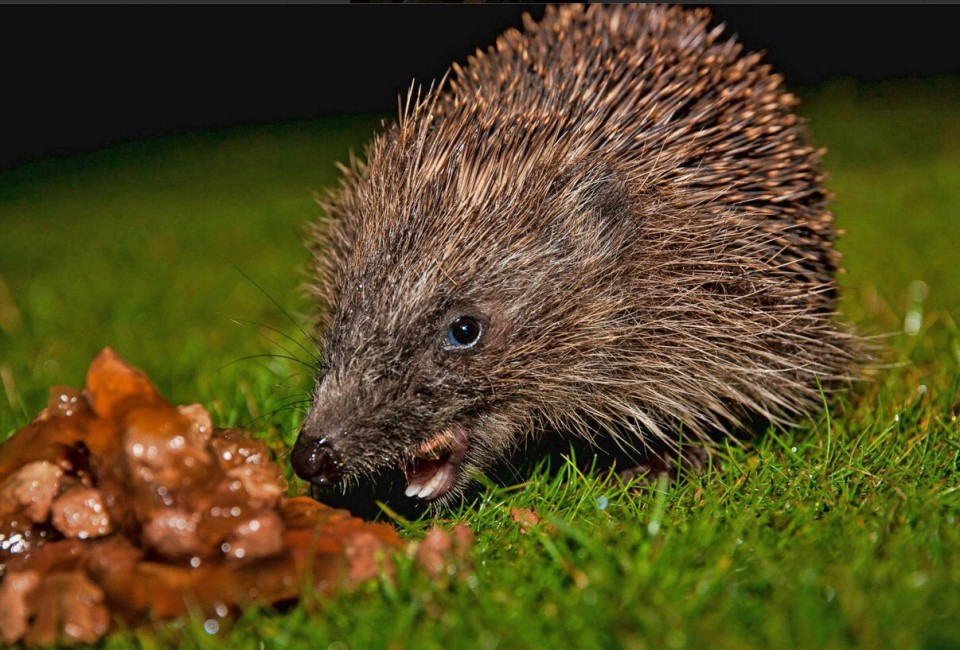
In females, lowest weights are often recorded immediately after emergence from hibernation, while the Ph.D. studies of Amy Haigh in Ireland and Hans Kristiansson in Sweden suggest male body weight is lowest during June and July, when foraging is reduced as they devote time to searching for mates. Peak weights for both sexes are generally attained in late autumn, just prior to the onset of hibernation. Haigh's studies, as well as data collected by Digger Jackson in the Outer Hebrides suggest that adult weight is relatively stable year to year.
Increasing age tends to be reflected by increasing girth rather than length and European individuals are generally larger than those found in the UK.
Appearance & colour
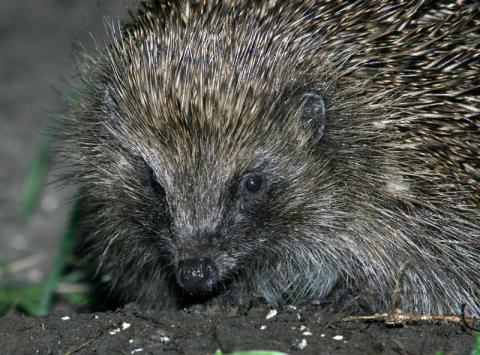
Hedgehogs are arguably the most easily identifiable of any British mammal. They have a rather unspecialised body form; each of their four feet has five toes, each with a sharp claw and several toughened pads of skin. Hedgehogs are plantigrade (i.e., they have small flat feet, the entirety of which is placed on the ground while walking), with forefeet measuring roughly 2.5 cm (1 in.) long by 3 cm wide, hind feet measuring 3 cm by 2 cm and a stride of 10 to 15 centimetres (4-6 in.). They have a fairly long snout covered with whisker-like hairs, small bright brown/black eyes that protrude slightly, and small ears about 1 cm (just under half-inch) tall.
In The New Hedgehog Book, Pat Morris notes that despite their apparent bulk, which results from loose-fitting skin, hedgehogs can squeeze under sheds, fences and through small holes. I've seen this several times, with an adult I was photographing on our driveway disappearing through a gap between the drive and nextdoor's fence -- a gap of only about 4 cm (2 inches).
Spines
The skin is covered with about 3,500 spines by the time the animal is weaned and leaves the nest -- an adult can have as many as 7,000 spines. The spines are hollow modified hairs, which grow from papillae in skin follicles and reach about 2.5 cm (1 in.) in length. Structurally, spines are composed of numerous transparent tubes arranged vertically that, as Les Stocker notes in his Complete Hedgehog, produces a lateral cross-section reminiscent of a piece of rolled corrugated card and is structurally quite distinct from the honeycomb arrangement found in the superficially similar quills of porcupines. In The Hedgehog, Maurice Burton describes the spines being composed of two layers: an outer cortex and an inner medulla, the tip being solid cortex.
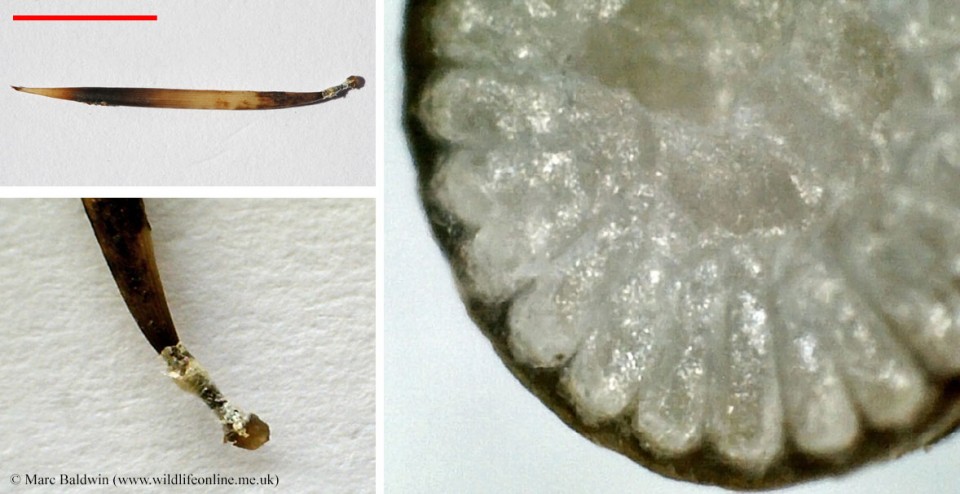
At the base of each spine is a small hemispherical bulb that provides superb anchorage in the skin (field observations have demonstrated a single spine can support the total weight of the hedgehog) and prevents the spine being driven into the hedgehog's body upon impact. The slight (ca. 60-degree) curvature of the spine immediately above the bulb, coupled with a width of only about a millimetre, provides optimal elasticity without kinking and allows the spines to act like shock absorbers.
In a paper on the mechanical design of hedgehog spines, published in the Journal of Zoology in 1986, Julian Vincent and P. Owers note that hedgehog spines are hollow tubes constructed of alpha keratin, with strips running along the internal length (longitudinal stringers) and horizontal discs at intervals along the length (septa); this internal structure provides stability against buckling. Indeed, the study found the stress at buckling of the spine is only 0.5% its compressive strength; even when the spine has exceeded its critical buckling load, it can take 200-times that load before it fails and is deformed permanently or broken. In other words, the spines deform and then "bounce back", so it takes a serious force to fold or break the spines. According to the researchers, this has a lot to do with the presence of the internal septa. Overall, Vincent and Owers conclude that:
"This mechanical design suggests that the hedgehog spine is an elastic strain energy store to protect the animal from impact, either from a predator or from falling. The uniformity of length of the spines over the dorsal pelt supports this interpretation since the energy storage will be the same no matter how the animal falls."
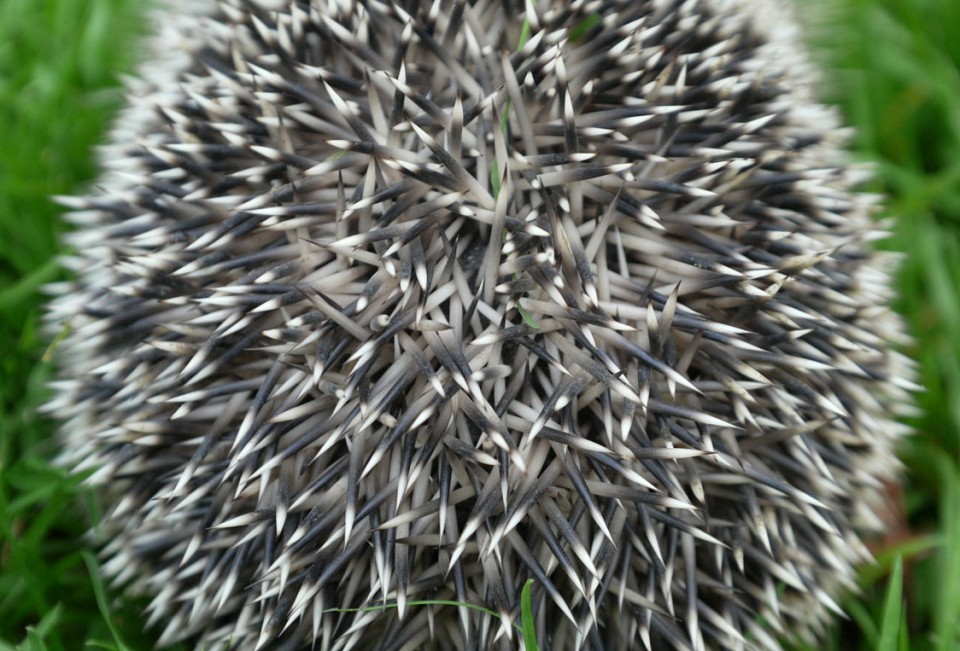
Each spine is attached to its own muscle, allowing each to moving independently and anchoring it to a large sheet of muscle lining the hedgehog's back called the panniculus carnosus. It is contraction of the panniculus that causes the hedgehog to roll up; a fringe of muscle running along the periphery of the panniculus, the muscularis orbicularis, then contracts to draw the hedgehog into a tight ball. The spines lie flat on the animal's back until it is alarmed, at which point they're erected and drawn down to cover the face, feet and tail as the hog lowers its nose to the ground. If the danger remains, or the hedgehog is touched, it will roll up completely. Erection of the spines is achieved via contraction of the muscles anchoring them to the panniculus -- each hair is embedded at a slightly different angle, producing an almost impenetrable barrage of intersecting spines. Hedgehogs put great faith in their spines to protect them and typically prefer to roll up and wait for danger to pass than run away. This defensive strategy works against most predators, but makes them vulnerable to badgers and more modern hazards such as cars and strimmers.
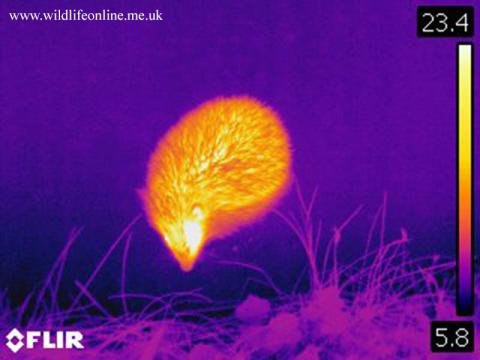
Moulting of spines is on an individual basis because moulting the entire coat at once would leave the animal defenceless; spines may thus be in place for several years. As far as I know, nobody as ever studied the "longevity" of a spine, but replacement seems to vary individually and in Hedgehogs Nigel Reeves talks about some hogs undergoing a "flush" of moulting. Some authors suggest spines may remain in place for up to two years, but Kathy Janio observed that some of the rubber identification sleeves attached to hedgehogs in her Sussex garden remained in place for as long as six years. It appears that each hair follicle has its own growth rate and isn't synchronised with any others. Individuals lacking both hair and spines (so-called bald or 'naked' hedgehogs) have been documented; total loss of both hair and spines may be the result of a (presumably rare) genetic abnormality, possibly a deficiency in keratin production. Disease such as demodectic mange (i.e., infestation with the mite Demodex, which lives in hair follicles) may cause spines to fall out, although these are re-grown once the infection is treated.
Completely bald hedgehogs are rarely reported from the wild, presumably because they don't survive long without their protective spines, and I'm only aware of a couple of examples. A spineless hedgehog was taken to the British Wildlife Rescue Centre in Staffordshire and a photo of the individual appeared in the June 2007 BBC Wildlife Magazine, next to Pat Morris' appraisal of the hog's condition. More recently, in September 2014, a naked hog was found near Glasgow and taken to Hessilhead Wildlife Rescue Trust.
A final curiosity about hedgehog spines is that they appear to fluoresce under ultraviolet light. This curious observation was first made in hedgehogs by Derrien and Turchini in a short French paper published in 1925. More recently, however, in a paper to the Journal of Chemical Ecology, published in 2021, University of Connecticut chemist Randy Hamchand and colleagues confirmed how, when they exposed hedgehogs to light in the UV range 365–395 nm, the tips of their spines glowed red. They then used a process called reflectance fluorescence spectroscopy to confirm Derrien and Turchini's original suspicion that this fluorescence was caused by pigments known as free-base porphyrins (specifically a mixture of coproporphyrin III, uroporphyrin III, and protoporphyrin IX) produced by bacteria living on the spines. We don't know whether this fluorescence is something the hedgehogs can see or use in any way, but the researchers considered that it was likely coincidental and of no biological significance.
Colour
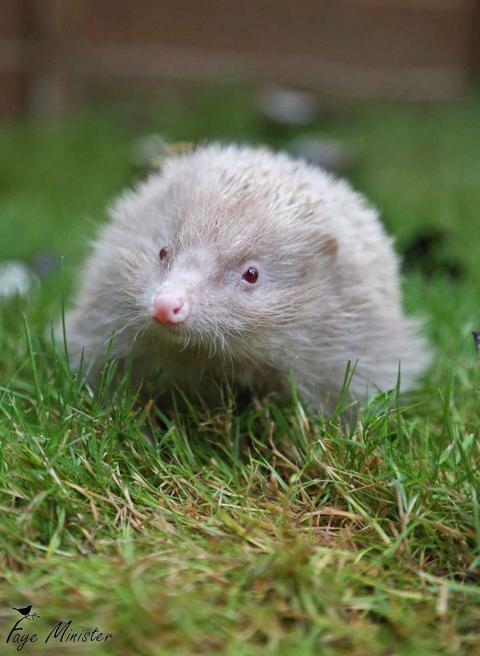
The spines are concentrated on the back and are creamy white in colour with a dark brown band around the middle; they're fringed by a "skirt" of coarse guard hairs that extends to cover much of the face. The underside of the body is covered by softer hairs, ranging in colour from white to dark brown, but coverage is sparse, allowing the skin to be easily seen. Indeed, hedgehogs are poorly insulated and observation of them using a thermal imaging camera reveals a "heat trail" left on the ground from the animal's stomach that persists for a minute or so.
Leucistic individuals have white or pale yellow spines and light breast colouration, giving them a "ghostly" appearance. In a 1996 paper to the Journal of Zoology, Pat Morris and Andrew Tutt from the University of London reported the results of a questionnaire distributed to the households on Alderney, where hedgehogs were introduced sometime after 1810. The survey found that 64 of the 95 respondents (67%) had seen "blonde" hedgehogs -- closer inspection found these to be leucistic animals with pale creamy-white spines and fur, black eyes and pink skin, claws and feet. During their study, the biologists performed transects across various sites on the island; they found 50 hedgehogs, 17 (34%) of which were leucistic -- leucism was not linked to either sex or age. More recent work marking and recapturing hedgehogs on Alderney by the local Wildlife Trust, led by Roland Gauvain, suggests that of the 1,300 or so hogs on the island, about 80% are now leucistic.
It seems that although the distribution of leucistic individuals was patchy on Alderney during Morris and Tutt's study, this presumably recessive genetic trait (observations by Gauvain and his colleagues describe litters with a mixture of blonde and brown hoglets) was considerably more common than on the mainland. In the same paper, the biologists mention how they have only come across three examples (two from Wales and one in Hampshire) of leucistic hogs during their three decades studying this species. It is suggested that the lack of mammalian predators on Alderney probably allows colour variants that would otherwise be highly conspicuous to flourish. Additionally, being generally more visible may make blonde hedgehogs less vulnerable to being runover.
Partially leucistic individuals with only patches of white have been found, and Nigel Reeves notes that it is not uncommon to find a normally-coloured animal with a few unpigmented spines. Albinism in hedgehogs is mentioned relatively frequently in the literature, although the albino condition is rare in mammals and I know of only a handful of confirmed albino hogs, most taken in by rescue centres. In one case, a litter of five orphaned hoglets was brought into Willows Hedgehog Rescue in Worcestershire during September 2014; one male in the litter was albino. Interestingly, unlike many other mammal species, I know of no melanistic (black) forms having been recorded. In his booklet Hedgehogs, Pat Morris suggests that probably fewer than one in 10,000 hedgehogs deviate so markedly from the normal colouration. That said, we have some data suggesting pigmentation may be associated with, or affected by, habitat. Isabelle Defosseux and colleagues, in their 2025 paper to Mammal Research, described a continuous variation in melanin-based colouration in hedgehogs that was negatively correlated with the level of urbanisation. In other words, among their sample of 55 hedgehogs collected from in and around Paris between September and November 2021, darker hedgehogs were less common in urban areas than light coloured ones. This is intriguingly contrary to what we see in other species, where darker pigmented animals tend to do better in towns and cities than paler ones. The researchers don't speculate as to the reason for this observation, but do point out that their study utilised photos submitted to rescue centres that are often found in poor condition.
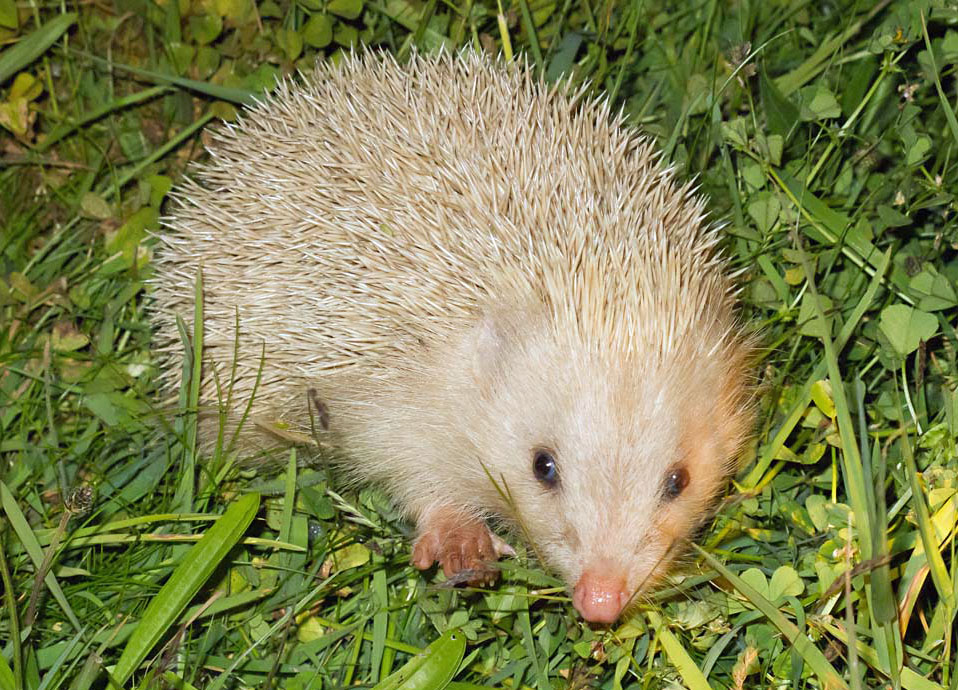
Internal morphology
Internally, hedgehogs have a very standard mammalian skeletal structure, modified with a short neck (although still consisting of seven vertebrae). The ulna and radius are fused near the elbow and the tibia and fibula fused near the ankles. Their vertebral column is particularly flexible, allowing them to roll up. They also have a small (2cm / three-quarters inch), spineless tail. The skull is between 54 and 64 mm (2-2.5 in.) long by 32 to 39 mm (~ 1.5 in.) wide with 36 teeth -- there are 24 deciduous (milk) teeth, which are lost in the first couple of weeks.
There are several unusual features of the hedgehog dentition, including the very prominent first incisors that are easily mistaken for canines. These incisors point forwards rather than inwards and are used for scooping up prey; this, coupled with the large gap between the front teeth that the lower incisors bite into, means the incisors do not form a sharp cutting edge. The teeth are arranged in the dental formula: 6-2-6-6 / 4-2-4-6.
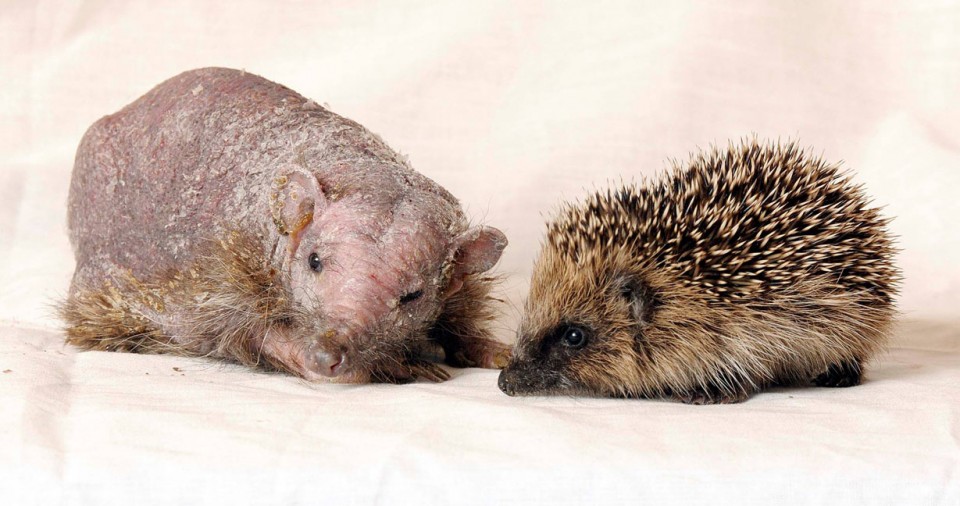
It appears that dental abnormalities can be common in some populations and, in a paper to Nature during 1964, Robert Brockie presented the results of his analysis of dental structures from hedgehogs in New Zealand. Combining his data with earlier findings by Konrad Herter, Brockie noted that 39 of the 77 skulls (almost 51%) had dental abnormalities -- typically extra teeth or faulty eruption of incisors or premolars. These figures are considerably higher than the abnormality rate of roughly 1-in-6 (just under 17%) seen in British hedgehogs. In his paper, Brockie wrote:
"This characteristic [heritable dental abnormality] was transmitted to New Zealand with the original stock of perhaps a dozen animals ... and has now become widespread and common there..."